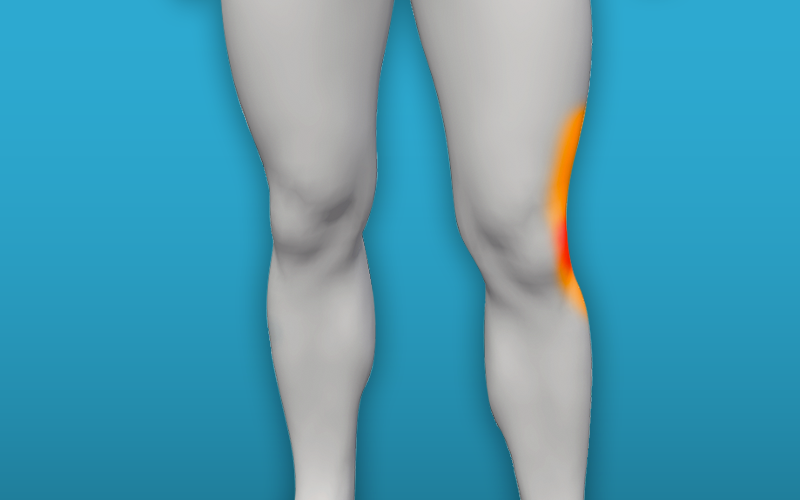
Lateral knee pain
What is it?
Lateral (outer) knee pain can be caused by several things, but the most common cause is Iliotibial Band Syndrome, an overuse injury due to the Iliotibial band moving across the outside of knee joint.

Muscles and ITB around the knee cap – picture showing the front of the knee
1 Tensor fasciae latae muscle
2 Vastus lateralis muscle
3 Iliotibial band
4 Vastus medialis muscle
5 Rectus femoris muscle
6 Vastus medialis obliquus muscle
This pain on the outside of your knee, is also called Runner’s Knee.
The iliotibial band, a thick band of fibrous tissue (3) that runs down the outside of the leg, works in coordination with several of the thigh muscles to provide stability to the knee and to help in flexion of the knee joint (see picture above). When irritated, movement of the knee joint becomes painful. Usually the pain worsens with continued movement, and resolves with rest.
How to manage it?
This involves relative rest, ice, and anti-inflammatory medications initially. This should improve pain, swelling and tenderness.
Exercises
Stretching the muscles on the outside of your leg will also help to increase mobility of the Iliotibial Band, quadriceps, hamstrings, gluteals and calf muscles.
The final important phase treatment includes a strengthening program and a progressive return to activities, such as running, once pain free.
Knee extensions
Sitting on a chair, slowly straighten your knee as high as it can go, hold for 5 seconds and slowly lower it down again.

Hamstring stretches
Take the leg you want to stretch in front of you, heel on the floor.
Move your pelvis backwards, bend the supporting leg and bend your trunk forward until you can feel a stretch in the back of your thigh.
Hold for 30 seconds. Repeat 3 times.

Iliotibial band stretch
Stand close to a wall for support. Cross your legs and lean away from the wall. Move your hip closer to the wall until you feel a stretch down the side of your leg.
Hold for 30 seconds. Repeat 3 times.

Squat
Stand tall with feet slightly wider than hip-width apart. Toes pointing forward or turned a few degrees outwards. Keep your chest up and your spine and neck in a neutral position.
Squat down by sitting back and bring your arms forward. Push back up through the heels, chest up, and straighten your hips.
Note
– Keep your hips, knees and toes aligned
– Keep your weight evenly on your whole foot.
Repeat 10 times rest 1 minute. Repeat 3 times.

Deep Squat
Squat down by sitting back and bring your arms upwards. Push back up through the heels, chest up, and straighten your hips.
– keep hips, knees, toes aligned.
– Go only as low as you feel comfortable with
– Keep weight evenly on whole foot.
Repeat 10 times rest 1 minute. Repeat 3 times.

Single-leg Mini Squat
Stand tall on one leg with the other leg raised behind.
Squat down keeping your knee in line with the toes and your pelvis level. Push back up to the starting position.
As your technique improves and pain reduces, you can progress the exercises to a deeper squat
Repeat times 10 times rest 1 minute. Repeat 3 times.

Pain relief
Painkillers like paracetamol will ease the pain, but need to be taken regularly in order to control the pain. Always follow the instructions on the packet.
Anti-inflammatories like ibuprofen can help with swelling, and therefore help you move more freely. Follow the instructions on the packet and discuss using them safely with a pharmacist, especially if you have any underlying health conditions
However, you should not take ibuprofen for 48 hours after an initial injury as it may slow down healing.
Up to date guidelines can be found on the NHS website:
Other medicines can help to reduce inflammation, swelling and pain. You should discuss this with your GP if the simple pain relief advice does not help or if you are needing to take ibuprofen for more than 10 days.
Ice
Some people find using ice helpful on the painful area.
For ice therapy use a damp cloth containing an icepack (or bag of frozen peas) over the top of the painful area to help numb the pain. Leave it on for up to 20 minutes and use up to 3 times a day.
- You should be cautious using these treatments if you have altered skin sensation or circulatory problems.
- Check the skin regularly during and after the ice pack application
- Stop if there is excessive pain, numbness or tingling
Do not put ice directly on to the skin as this may cause a burn.
Physiotherapy
If you find that you are not improving, some advice or treatment from a physiotherapist can be helpful in managing knee pain. Click here to self-refer to a physiotherapist.
